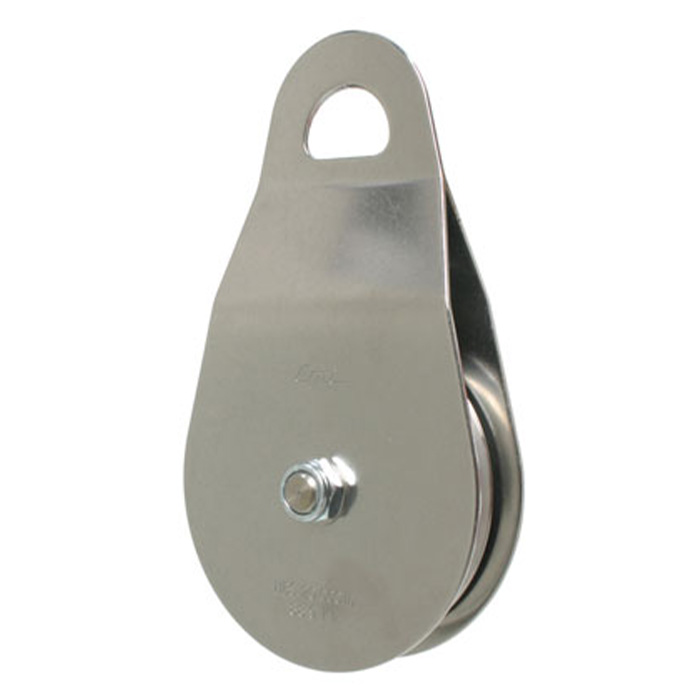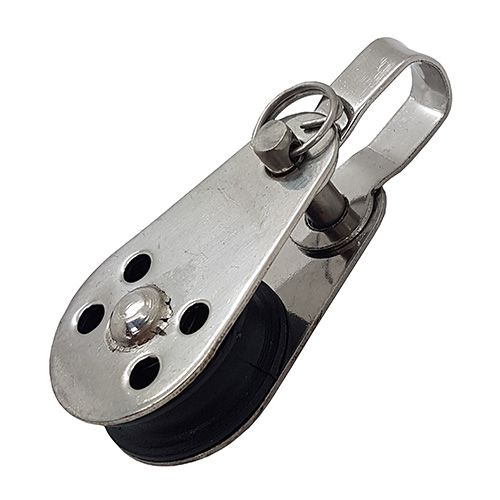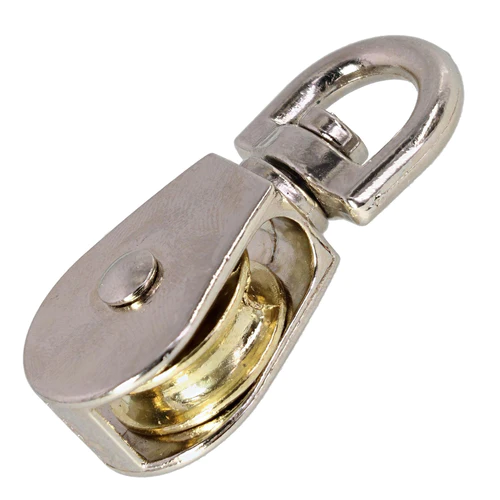Product Description
stainless steel conveyor rollers conveyor idler roller for conveyor pulley belt system
Product Description
Hyton provides one-stop solution service for your metallurgical equipment spare parts, currently we produce rolling mill rolls, guide, blades, gears, sprocket wheels, worm, worm gears, flange processing parts, welding processing parts and etc.
Rolls do the most important work in a rolling mill. They constitute a very important component of the running cost of the rolling mill. Hence, it is necessary that optimum performance is obtained from the rolls. Rolls come in a wide variety of sizes, the smallest roll weighs only a few kilograms, the heaviest around 250 tons a piece, and the variety of grades used is also wide, from ductile iron (spheroidal graphite iron) to tungsten carbide, covering all kinds of tool steels and special steels, used only for rolls. Roll properties include blend of hardness and strength as well as resistance to thermal cracking, shock loading, and wear.
| Product Name | Conveyor Pulley |
| Size | Customized |
| Color | Customized |
| Technology | Forging |
| Surface Treament | Paint Spraying, Grind Machining, Heat Treatment |
| Material | Alloy steel, Carbon steel, Carburizing steel, Quenched and Tempered steel |
| Inspection | Chemical Composition Test, Ultrasonic Test, Penetration Test, Radiographic Test, Magnetic Test, Tensile Strength Test, Impact Test, Hardness Test, Dimension Test |
| Payment | L/C, Western Union, D/P, D/A, T/T, MoneyGram |
| Lead Time | 4 weeks |
Chemical Component
| C | Si | Mn | Cr | Ni | Mo | HS | Mpa |
| 0.50-0.60 | ≤0.40 | 0.50-0.80 | 0.50-0.80 | 1.40-1.80 | 0.15-0.30 | 55-58 | ≥1200 |
| 0.40-0.47 | 0.40-0.70 | 0.40-0.60 | 1.50-2.00 | 0.80-1.20 | 0.80-1.20 | 54-56 | ≥1200 |
| 0.32-0.42 | 0.80-1.20 | ≤0.40 | 4.50-5.50 | 1.60-2.40 | 2.00 | ||
| 0.35-0.45 | 0.80-1.20 | 0.25-0.70 | 3.00-3.75 |
Company Profile
HangZhou CHINAMFG Heavy Industry Technology Development Co., Ltd. is a leading enterprise in the wear-resistant casting of large engineering machinery and the forging of large equipment parts located in the New Material Industrial Park, Xihu (West Lake) Dis. High-Tech Zone, HangZhou City, the company covers an area of 90 Square kilometer and currently has more than 300 employees. The company is equipped with lost molding production line and lost casting production line imported from FATA Company in Italy, Inductotherm Vacuum Degassing Furnace(USA), Foseco Casting Technology(U.K), SPECTRO Spectrometer (Germany), the currently most advanced ZZ418A vertical parting flaskless shoot squeeze molding machine Disa production line, horizontal molding line and self-control lost casting production line in China, the most advanced sand treatment system in China. With 3 gas trolley heat treatment CHINAMFG and pusher-type CHINAMFG full-automatic heat treatment production lines, the company can annually produce 30,000 tons of various wear-resisting castings and metallurgical equipment forging parts.
Manufacturing Technique
Packing and Shipping
To better ensure the safety of your goods, professional, environmentally friendly, convenient and efficient packaging services will be provided. After goods well packaged, we need only 1 day ship goods to ZheJiang port, which means that most of the spare parts you bought from Hyton, it will get your port within 45 days all around the world if shipment by sea.
Our Advantages
1)Your inquiry related to our product & price will be rapidly.
2) Well trained & experienced staff are to answer all your inquiries in English of course.
3) Your business relationship with us will be confidential to any third party.
4) One stop purchase service: extensive rang of products for qualified offering.
5) We response to client’s inquiry within 12 hours.
FAQ
1.Q: What kind of products do you make?
A: We specialize in metallurgical equipment casting and forging parts, such as forging rolls, guide, blades, gears, sprocket wheels, worm, worm gears, flange processing parts, welding processing parts and etc.
2.Q: What kind of material do you offer?
A: High manganese steel, high chrome iron, alloy steel, low carbon steel, medium carbon steel, Stainless Steel and etc.
3.Q: What is your time of delivery?
A: Our lead time is generally 2-4 weeks for casting parts and shipping time is about 2-4 weeks.
4.Q: How to test your quality?
A: We will show you material inspection and measurement inspection after fininsh the goods, at the same time, we will give you the life time guarantee letter after shipping the goods. The best suggestion to all the customer who may interest our product-Test 2 set first, all the good business relationship all from test and trust.
| Material: | Steel |
|---|---|
| Application: | Chemical Industry, Mining Transport |
| Structure: | Ordinary Roller |
| Bearing Type: | Double Sealed Bearing |
| Type: | Parallel Conveyor Idler |
| Transport Package: | Standard Packing |
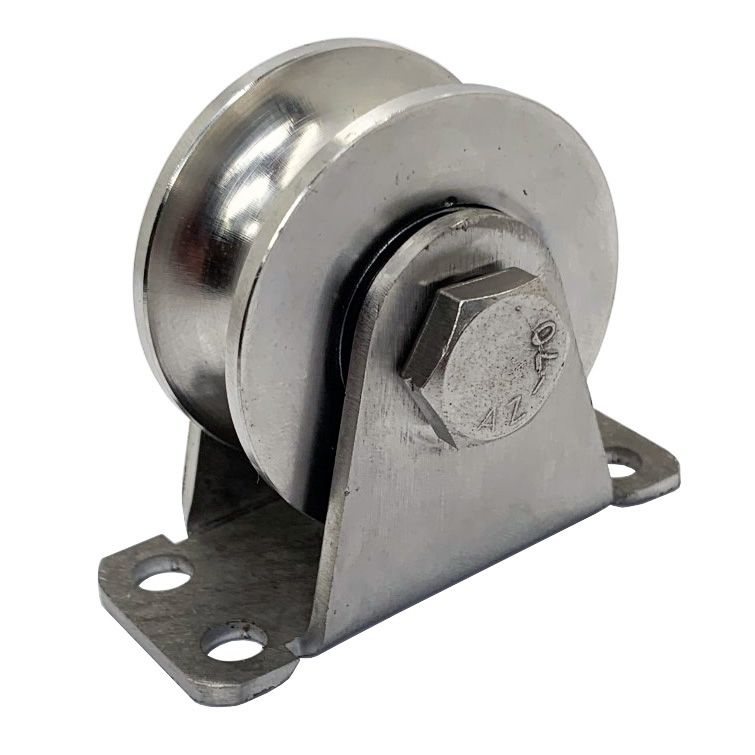
How do stainless pulleys contribute to the efficient and corrosion-resistant operation of systems?
Stainless pulleys play a crucial role in ensuring the efficient and corrosion-resistant operation of various systems. Here’s how they contribute:
- Corrosion Resistance: Stainless pulleys are made from stainless steel alloys that exhibit excellent corrosion resistance. Stainless steel contains chromium, which forms a passive oxide layer on the surface, protecting the pulley from corrosion caused by moisture, chemicals, and environmental factors. This corrosion resistance ensures the longevity and reliability of the pulleys in harsh operating conditions.
- Durability: Stainless pulleys are known for their durability and robustness. They can withstand heavy loads, high pressures, and repetitive motion without deforming or failing. The inherent strength of stainless steel ensures that the pulleys maintain their shape and performance over time, contributing to the overall efficiency and reliability of the system.
- Smooth Operation: Stainless pulleys are precision-engineered to provide smooth and consistent operation. The pulley’s design, including its groove shape, diameter, and surface finish, ensures proper belt or rope tracking, minimizing friction and energy loss. This smooth operation reduces wear and tear on the system components, enhances energy efficiency, and allows for more precise control of the system’s movement and speed.
- Low Maintenance: Stainless pulleys require minimal maintenance compared to pulleys made from other materials. Their corrosion-resistant properties eliminate the need for frequent cleaning or protective coatings. Additionally, stainless steel’s resistance to wear and fatigue reduces the need for frequent replacement, resulting in lower maintenance costs and increased system uptime.
- Hygienic Compliance: In industries such as food processing and pharmaceuticals, maintaining hygienic conditions is critical. Stainless pulleys are easy to clean and sanitize, making them suitable for applications where strict hygiene standards must be met. Their smooth surface finish prevents the accumulation of contaminants and allows for thorough cleaning, reducing the risk of product contamination.
- Compatibility with Food and Pharmaceutical Regulations: Stainless pulleys are widely accepted in the food processing and pharmaceutical industries due to their compatibility with regulatory standards. Stainless steel alloys like 304 and 316 meet the requirements of various food and pharmaceutical regulations, such as FDA (Food and Drug Administration) and EHEDG (European Hygienic Engineering & Design Group) guidelines. This ensures compliance with industry regulations and contributes to the safe and efficient operation of systems.
Overall, stainless pulleys provide the necessary corrosion resistance, durability, smooth operation, low maintenance requirements, hygienic compliance, and compatibility with regulatory standards. These qualities contribute to the efficient and reliable operation of systems across various industries.
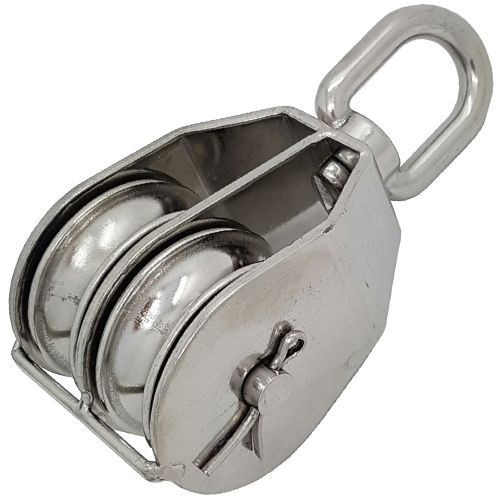
How are stainless pulleys customized for specific applications and load-bearing requirements?
Stainless pulleys can be customized to meet specific applications and load-bearing requirements. Here are some common methods and considerations for customizing stainless pulleys:
- Size and Dimensions: Stainless pulleys can be manufactured in various sizes and dimensions to accommodate different belt widths, rope diameters, or cable sizes. Customizing the size ensures proper fit and alignment with the rest of the system.
- Load Capacity: The load-bearing capacity of a pulley is a critical factor in its customization. Stainless pulleys can be designed to handle specific load requirements by adjusting the material thickness, reinforcing the structure, or using high-strength stainless steel alloys.
- Bearing Type: Pulleys can utilize different types of bearings depending on the application requirements. Customization involves selecting the appropriate bearing type, such as ball bearings or roller bearings, to ensure smooth rotation and efficient power transmission.
- Coatings and Finishes: Stainless pulleys can be customized with coatings or finishes to enhance their performance. For example, a non-stick coating can be applied to reduce friction and prevent material buildup. Corrosion-resistant coatings can be used for added protection in corrosive environments.
- Special Features: Depending on the application, stainless pulleys can be customized with special features. This may include flanges, grooves, or specific profiles to accommodate unique belt or rope configurations. Custom features can optimize the pulley’s interaction with the rest of the system.
- Environmental Considerations: Customization of stainless pulleys also takes into account the specific environmental conditions in which they will be used. Factors such as temperature extremes, exposure to chemicals or moisture, or compliance with industry regulations are considered to ensure the pulleys are suitable for the intended environment.
Customizing stainless pulleys for specific applications and load-bearing requirements requires collaboration between pulley manufacturers, engineers, and end-users. By considering factors such as size, load capacity, bearing type, coatings, special features, and environmental conditions, stainless pulleys can be tailored to provide optimal performance, reliability, and longevity in a wide range of industrial applications.
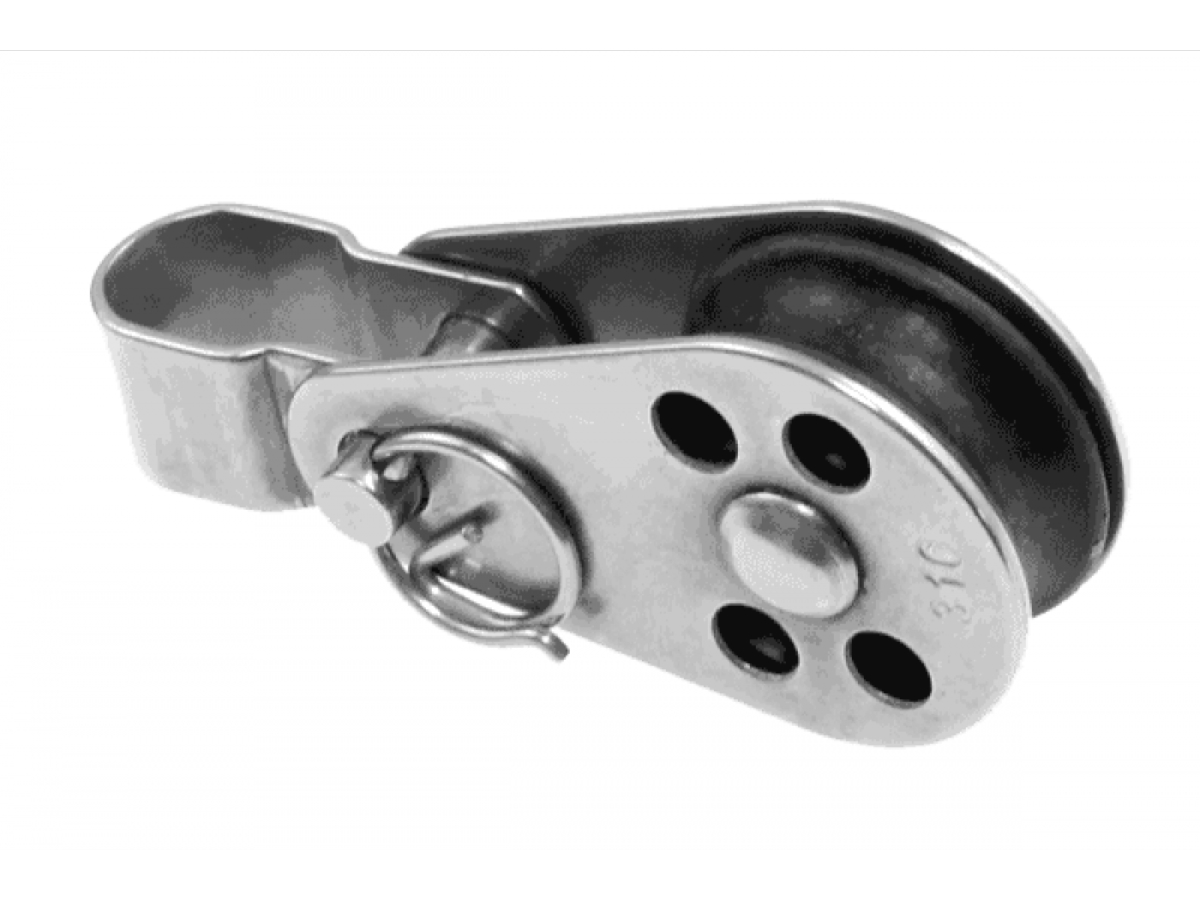
What types of materials are typically used for the sheaves or wheels of stainless pulleys?
The sheaves or wheels of stainless pulleys are typically made from various materials to meet specific performance requirements. Here are some common materials used for the sheaves or wheels of stainless pulleys:
- Stainless Steel: Stainless steel sheaves or wheels are commonly used in stainless pulleys to ensure compatibility and consistency in terms of corrosion resistance and durability. Stainless steel sheaves can be made from the same stainless steel grade as the pulley body, providing a cohesive and robust construction.
- Nylon: Nylon is a popular choice for sheaves or wheels in stainless pulleys due to its excellent wear resistance, low friction coefficient, and self-lubricating properties. Nylon sheaves are lightweight, durable, and suitable for applications that require quiet and smooth operation.
- Acetal: Acetal, also known as polyoxymethylene (POM), is another material used for sheaves or wheels in stainless pulleys. Acetal sheaves offer good mechanical strength, wear resistance, and low friction characteristics. They are often chosen for applications that involve high speeds or where chemical resistance is required.
- UHMW (Ultra-High Molecular Weight Polyethylene): UHMW is a high-performance plastic known for its exceptional impact strength, abrasion resistance, and self-lubricating properties. UHMW sheaves or wheels are suitable for heavy-duty applications where resistance to wear, impact, and noise reduction are important.
- Cast Iron: In certain industrial applications, particularly those involving heavy loads and high stress, cast iron sheaves or wheels may be used in stainless pulleys. Cast iron provides excellent strength and durability, making it suitable for demanding applications such as mining or construction.
- Aluminum: Aluminum sheaves or wheels are lightweight and offer good corrosion resistance. They are commonly used in stainless pulleys where weight reduction is desired without compromising strength and performance.
The selection of the sheave or wheel material depends on factors such as the specific application requirements, load capacity, environmental conditions, and desired performance characteristics. By choosing the appropriate material, stainless pulleys can achieve optimal functionality, durability, and efficiency in their respective applications.


editor by CX
2023-11-08
